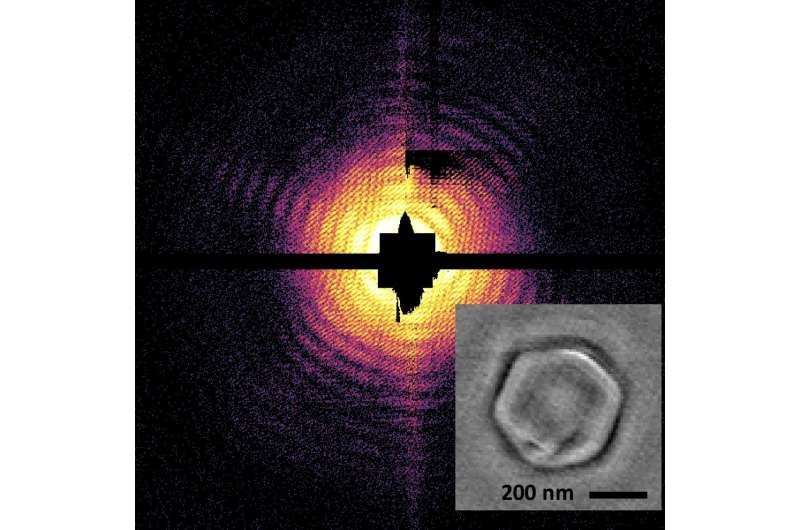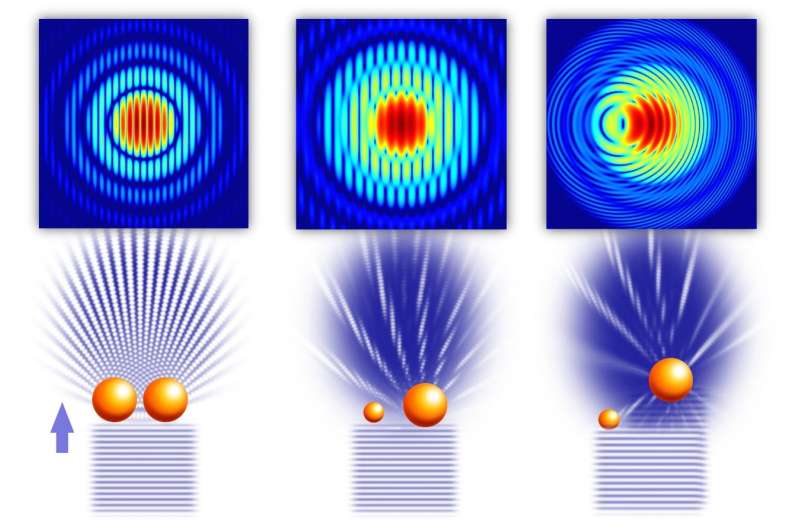With laser light, scientists create first X-ray holographic images of viruses

Holography, like photography, is a way to record the world around us. Both use light to make recordings, but instead of two-dimensional photos, holograms reproduce three-dimensional shapes. The shape is inferred from the patterns that form after light ricochets off an object and interferes with another light wave that serves as a reference.
When created with X-ray light, holography can be an extremely useful method for capturing high-resolution images of a nanoscale object—something that is so small, its size is measured in nanometers, or billionths of a meter.
So far, X-ray holography has been restricted to objects that form crystals or relied on careful positioning of the sample on a surface. However, many nano-sized particles are non-crystalline, short-lived and very fragile. They may also suffer changes or damage during an experiment when positioned on a surface. Aerosols, exotic states of matter, and the smallest forms of life often fall into these categories and therefore are difficult to study with conventional imaging methods.
In a recent study featured on the March 2018 cover of Nature Photonics, researchers developed a new holographic method called in-flight holography. With this method, they were able to demonstrate the first X-ray holograms of nano-sized viruses that were not attached to any surface.
The patterns needed to create the images were taken at the Linac Coherent Light Source (LCLS), the X-ray free-electron laser at the Department of Energy's SLAC National Accelerator Laboratory. Nanoviruses have been studied at LCLS without a holographic reference, but the interpretation of the X-ray images required many steps, relied on human input and was a computationally challenging task.
In the new study, the authors superimposed scattered X-ray light from the virus with scattered X-ray light from a reference nano-sized sphere. The curvature in the superimposed images from the two objects provided depth information and details about the shape of the 450-nanometer-wide virus, the mimivirus. This technique greatly simplified the interpretation of the data.
"Instead of thousands of steps and algorithms that potentially don't match up, you have a two-step procedure where you clearly get the structure out of your image," says lead study author Tais Gorkhover, a Panofsky Fellow at SLAC and researcher at the Stanford PULSE Institute.
Now, the scientists can do their reconstruction of a sample in fractions of a second or even faster with the holographic method.
"Before our study, the interpretation of the X-ray images was very complicated and the structure of nanosamples was reconstructed long after the actual experiment using non-trivial algorithms," says Christoph Bostedt, a scientist at the DOE's Argonne National Laboratory and a co-author of the study. "With 'in-flight' holography, the procedure is very simple and in principle can be performed while taking data. This is a real breakthrough."

"Another advantage of the in-flight holography method is that it is less prone to noise and to the artifacts that can appear in the detector compared to non-holographic X-ray imaging," says Anatoli Ulmer, a co-author and Ph.D. student from the Technical University of Berlin in Germany.
In the long run, the researchers predict that in-flight holography will offer new ways to study air pollution, combustion and catalytic processes, all of which involve nanoparticles.
More information: Tais Gorkhover et al. Femtosecond X-ray Fourier holography imaging of free-flying nanoparticles, Nature Photonics (2018). DOI: 10.1038/s41566-018-0110-y
Journal information: Nature Photonics
Provided by SLAC National Accelerator Laboratory




















